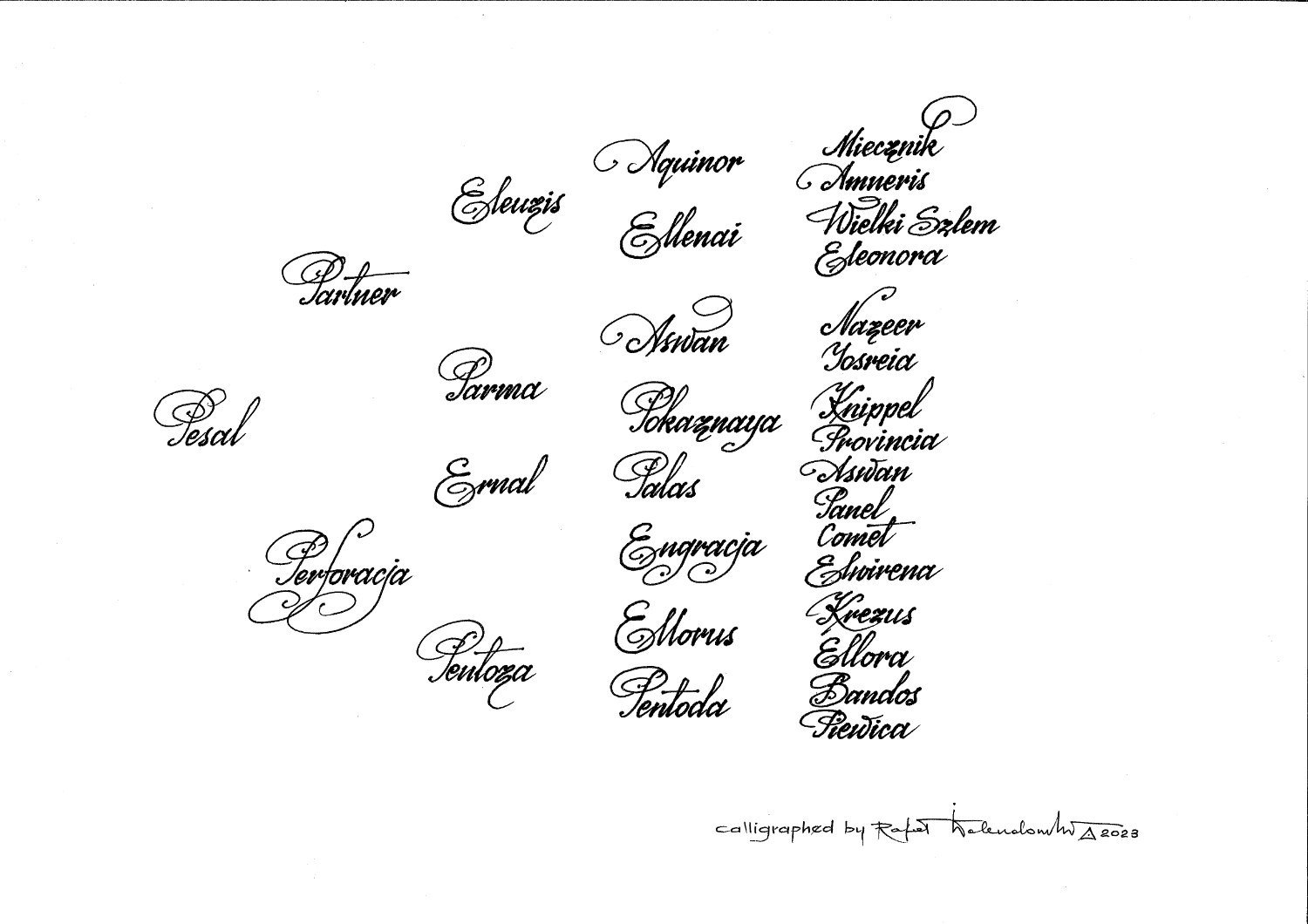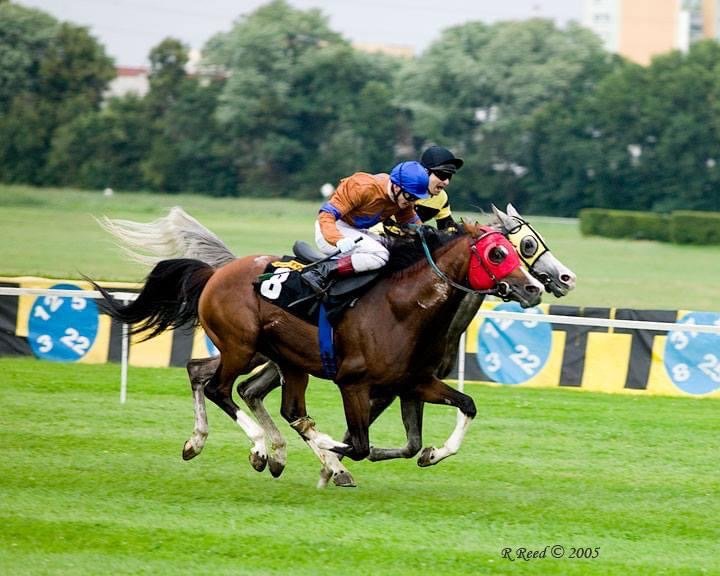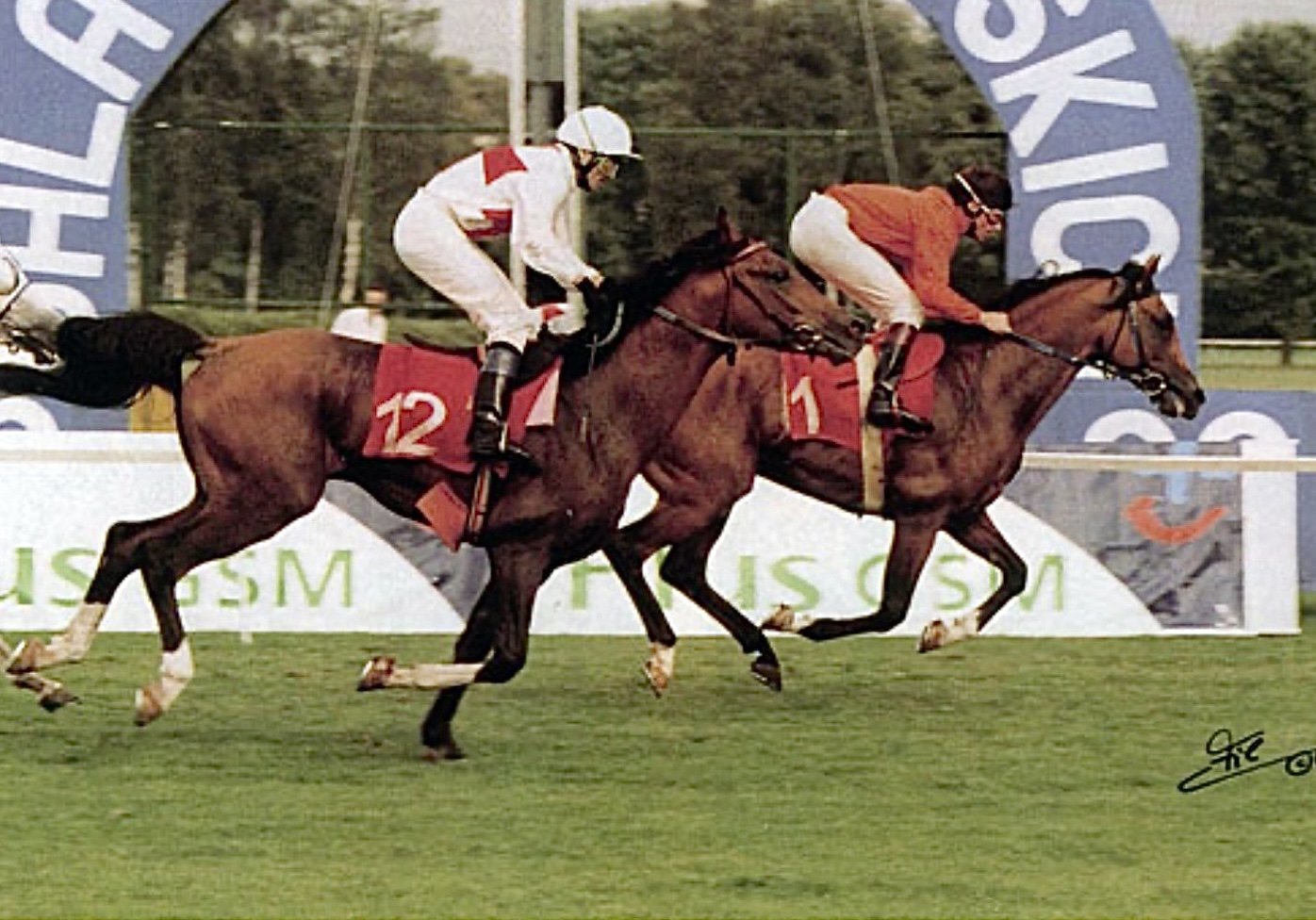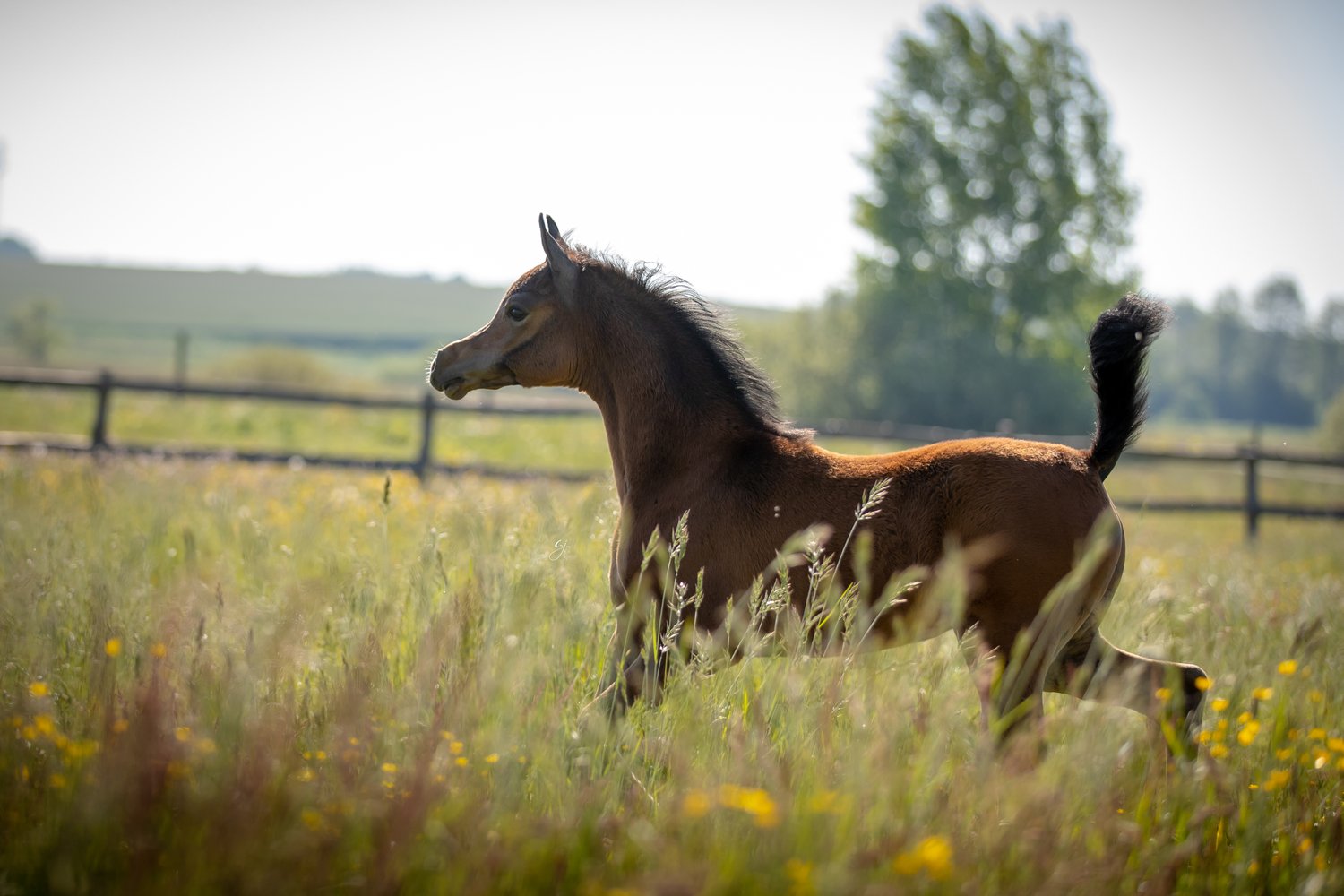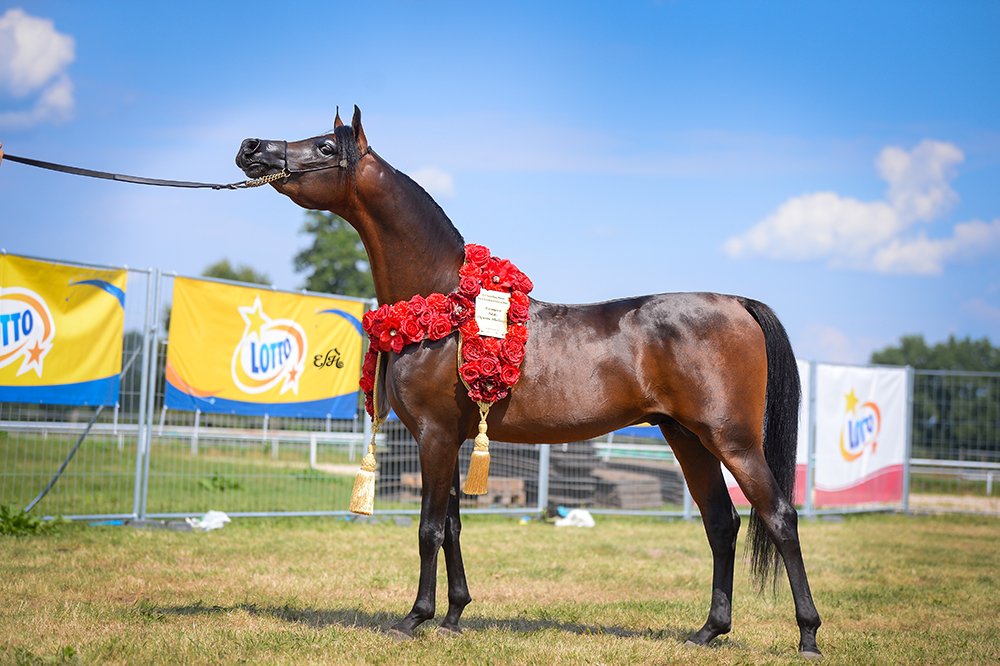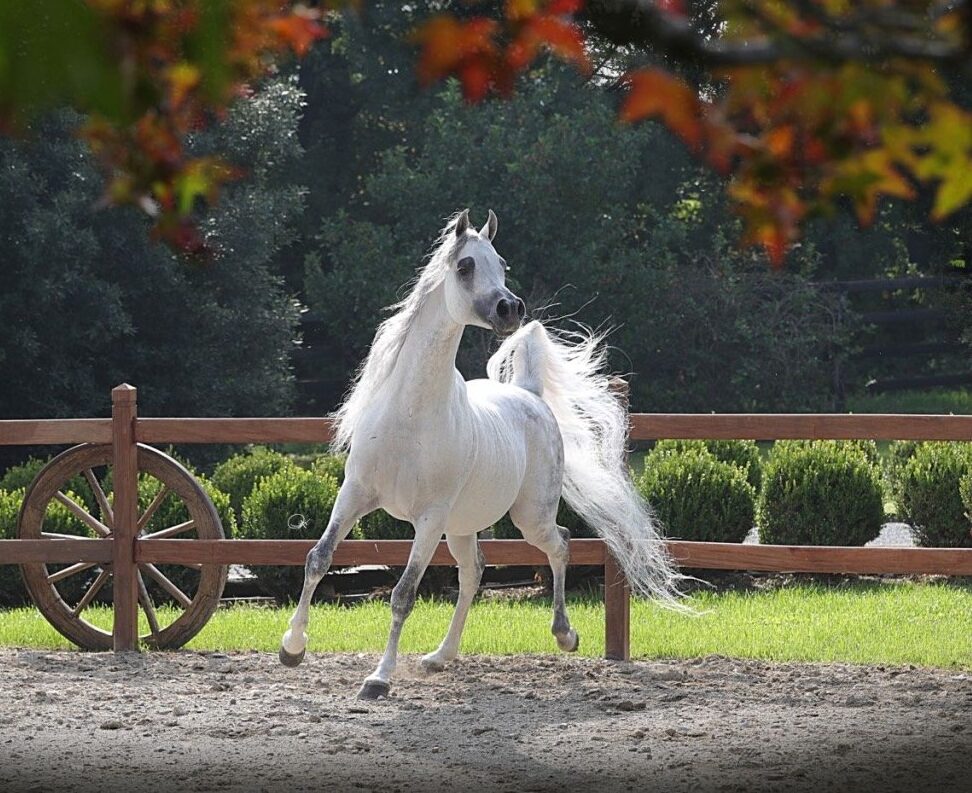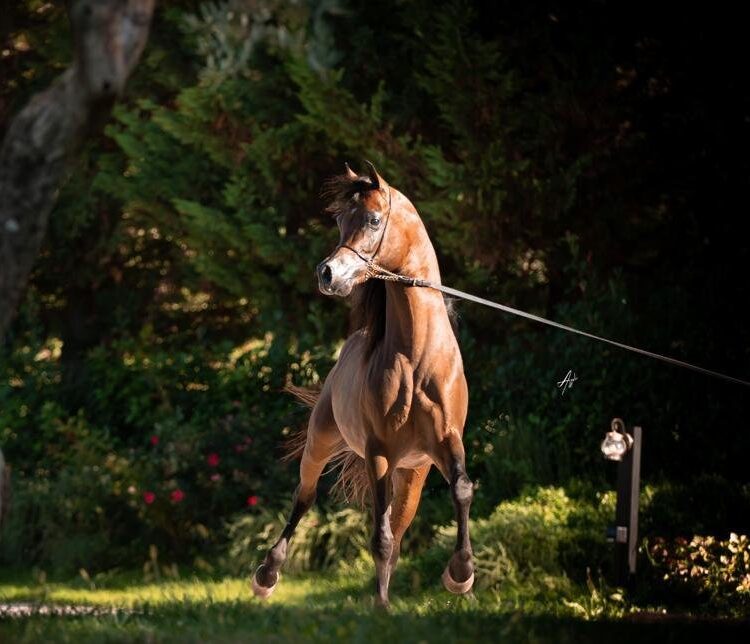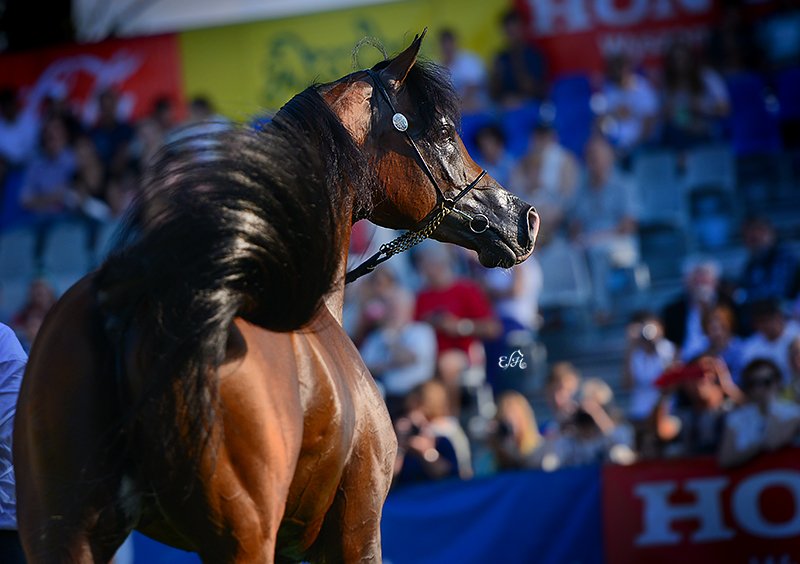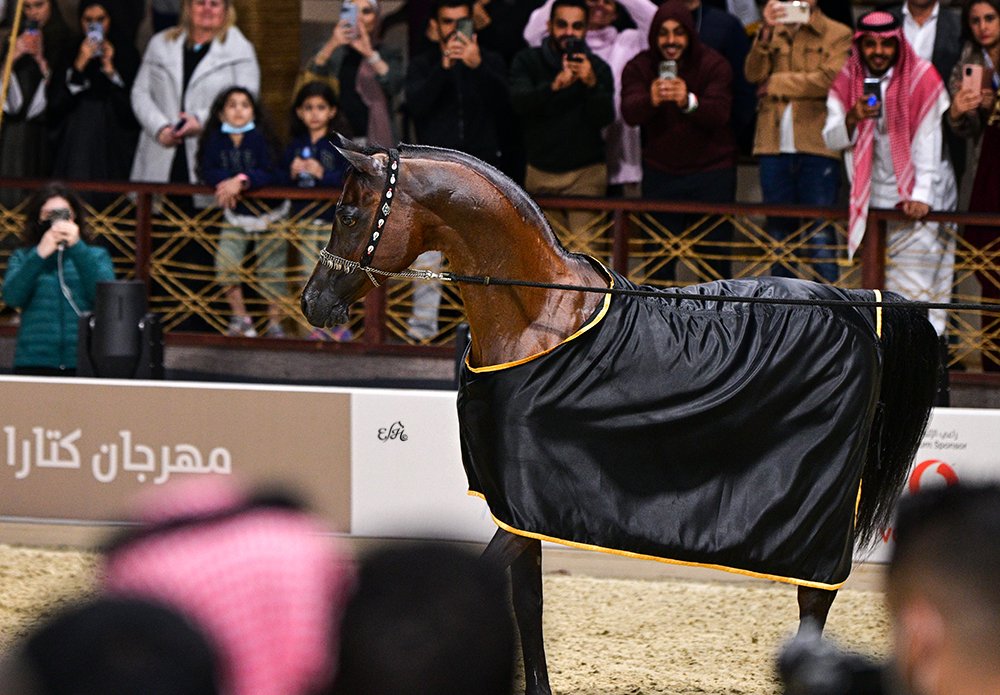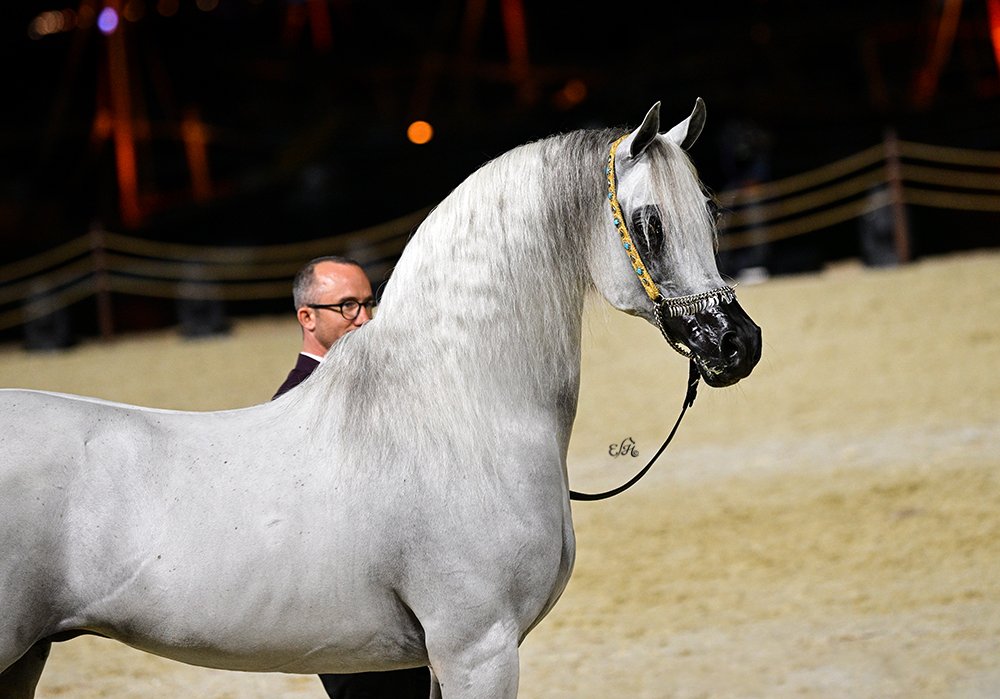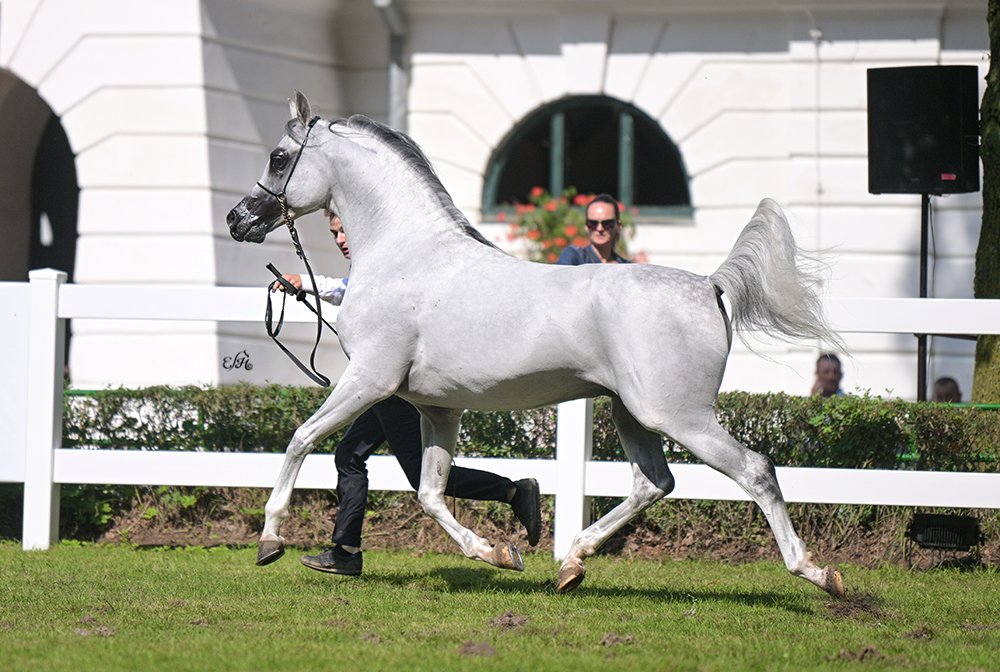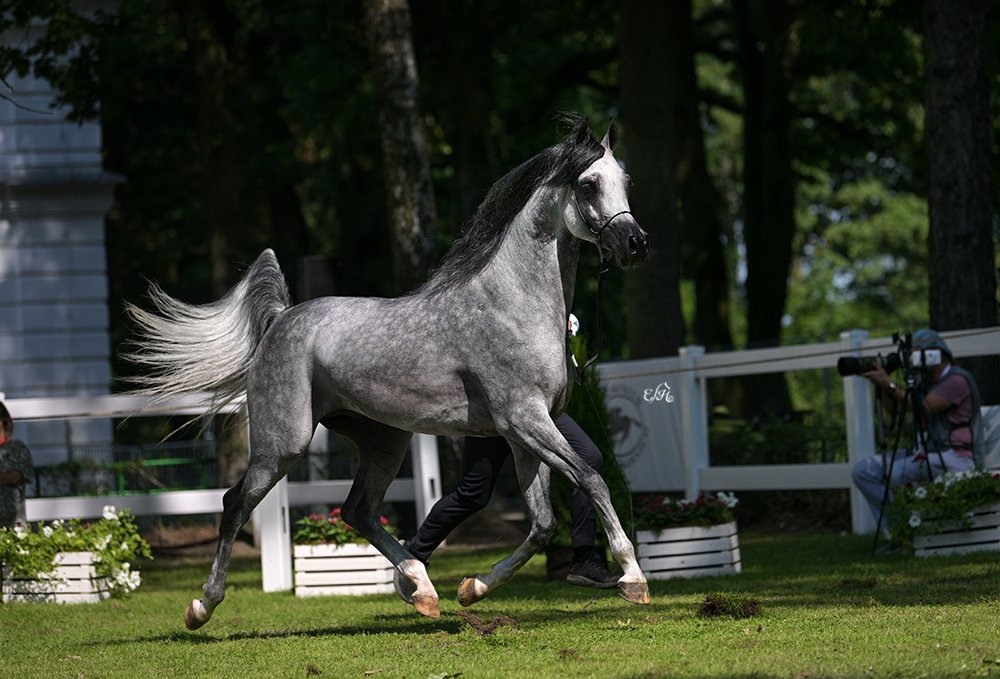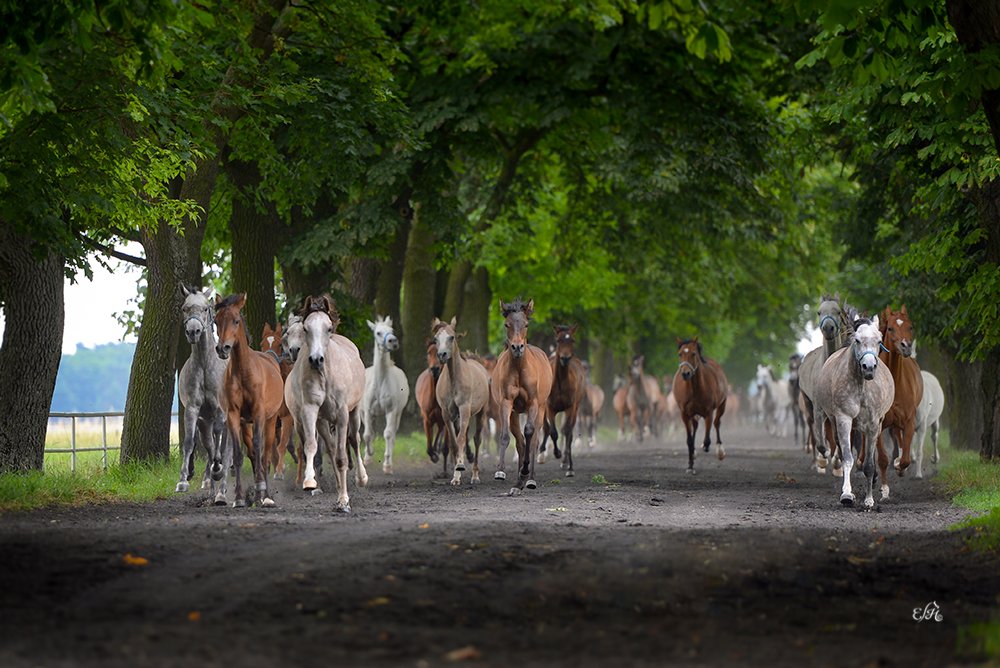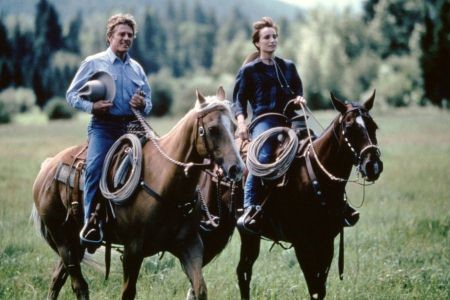ARTICLES
From stallion to sire – towards selection response (breeding progress)
Maciej Paweł Grzechnik
An extensive pedigree of a modern stallion, drawing by R. Walendowski
Zootechnic aspects of horse breeding or levels of selecting stallions.
Statistically half of all
horses born are stallions. However, only one stallion in a hundred becomes a sire.That is worth
remembering while looking at stallions occupying the box of chief sire. So what does it take to make
a mature sire out of a young colt?
Animal science (zootechnics)
deals with animal husbandry and breeding. It encompasses not only such disciplines as genetics,
reproduction and feeding, but covers also animal improvement. Thus, animal science provides
scientific foundations for actions undertaken by horse breeders. These actions entail continuous
efforts to improve the genetic structure of the animal population – here horses – reared in given
environmental conditions through the application of various breeding methods. Animal improvement, or
breeding work can be divided into stages: choosing animals for breeding (mating pairs), recording
their production value and evaluating the breeding value of individuals qualified for further
breeding. The last of these stages, involving the proces of evaluating and selecting a given
individual for breeding, consists of three selection levels. These levels ultimately enable us to
find the required stallion that qualifies for further breeding. In order to do so, initially one has
to determine the value of a stallion assigned for reproduction. In the proces, distinction has to be
made between two fundamentally different terms used in breeding: production value and breeding
value.
The races test the bravery of Polish Arabian horses, photo R. Reed
Production value denotes the level of performance set by the environment that
can be measured, horse racing being an excellent example of same. Breeding value, on the other
hand, is a genetically determined ability of a farm animal to transmit to his offspring certain
revealed trait or traits. Such ability results from an aggregate effect of genes upon a
certain quantative trait – with respect to horses such traits being speed and bravery. A
sufficiently valid indicator of an animal’s breeding value is the difference between his own quality
and the average quality of his native population achieved in average environmental conditions, which
constitutes the so called selection differential. Information about the breeding value of a stallion
is very important, as it serves as an excellent criterion upon which efficient selection can be
made, thus leading to selection response.
Druid (Wojsław - Dalida by Probat), photo Irina Filsinger
Unfortunately, a breeder is unable to assess directly the breeding value of a
given individual, as it resides in the phenotypic value of a given trait. Therefore, he needs to use
data referring to a specifically defined trait. These traits under consideration are performance of
ancestors, own performance, performance of his offspring and collateral, as well as a combination of
these sources. The efficiency of such analysis depends on the quality and accuracy of data at the
breeder’s disposal originating from the control of a given animal’s performance results, as well as
these of his collateral. As regards the Arabian horse, it is extremely difficult to obtain such
results, as we lack breeding activities that could fulfill the function of such control.
Additional difficulty stems from the fact that the bravery trial has been abandoned (bravery trial
being an objective, though not a determinant method of evaluation) as well as from the bonitation of
horses before their incorporation into the herd (meaning phenotypic compatibility with the standard
adopted by the breeding program). The lack of credible methods of controlling (evaluating)
performance has a negative impact upon the pace of the selection response (breeding progress) within
a herd of Arabian horses. Contemporary horse shows do not fulfill that controlling function either,
since the evaluation methods applied there are subject to many variables, starting from subjective
view based on personal preferences, through the play of contraditory interests among judges, till
the lack of professional knowledge, such as no understanding of the relationship between the horse’s
anatomy and his performance, as well as striking ignorance as to the purpose of breeding and
the native (Polish) breeding program. Despite all those limitations and difficulties, the only
proper method to select a sire is the three level selection based upon the following
criteria:
I - pedigree
II -
individual performance
III - performance of offspring and
collateral
Equator, photo Ewa Imielska-Hebda
I level: evaluation upon pedigree
Simple
service registers compiled already in the 18th century not only enabled to arrange first shallow
pedigrees, but first and foremost, they marked the beginning of modern and concious breeding. With
the addition of new generations, pedigrees became so extended, that today horses with the oldest
pedigrees, such as thoroughbreds or trakehners, boast of pedigrees counting thousands of ancestors.
Not many less generations can be traced among the Polish Arabian horses, whose known ancestors date
back to the first decade of the nineteenth century. Thus, the pedigree of a contemporary stallion
consists of thousands of ancestors known by their name, but often also by their individual traits,
inluding performance. Additional valuable information revealed by the pedigree include affiliation
to a given breeding line, methods of mating used or possible relation (kinship) with the population
where the stallion is to be used. Such data present in the pedigree allow us to draw conclusions
regarding what to expect from a given individual. However, the majority of breeders ignore that
aspect of a horse’s pedigree. Instead, the pedigree is used mainly to identify valuable horses
present in that pedigree. Simply speaking, at this stage of selection, the knowledge (but mainly
from heresay) of famous horses by known names may constitute a decive factor in the usefulness of a
pedigree for a given breeding. Nowadays, pedigrees of most solid breedings fulfill the analysis of
pedigree so understood, and all of them have in their pedigrees famous ancestors.
Unfortunaly, the fame of several ancestors in an extended pedigree is not enough. Such approach
often results in a distorted and erroneous view of an individual’s quality, but primarily of his
usefulness in a given herd. The availablity of qualitative data including the performance and
achivements of ancestors of an individual under evaluation increases the accuracy of conclusions
that may be drawn to assess properly the breeding value.
Etien MJ (Cyclone OS - Eleanor MJ by Empire), photo Glenn Jacobs
II level: evaluation upon individual performance
Initial information about the individual performance of a
stallion can be obtained already in the early stages of his life. Successive information appear as
the individual achieves reproductional maturity (primarily regarding fertility, quality of semen,
build or character). While evaluating the breeding value of an individual upon criteria not related
to his sex, where the source of information lies in his own performance (quality), it is necessary
to take into consideration the difference between own performance and average performance for the
population, as well as the trait heritability rate. The term performance denotes any given trait or
a combination of traits revealed in the phenotype related to production value, build or other that
are preferred by the breeder. Evaluation of performance constitutes an important element in the
process of selecting stallions for breeding (especially in half-breds, but neglected in
purebred arabian horses in Poland) as well as quality assesment of a male individual in the
case of pure races. Evaluation of performance also entails the assessment of individual
characteristics of a given horse, such as build, character or aptitude for a given usage. This is a
very important level, as performance in sports, racing or even shows (as in the case of a
segment of Arabian horse population) determines future utility of a stallion as sire. In the case of
Arabian horses, only a limited number of candidates manage to pass that evaluation
positively: not more than very few of them can become in a given year a champion of the most
important shows, the world championships, european championships or winners of classical prizes.
Basically, stallions from outside of this elite are beyond any interest, as the use of a sire that
does not fulfill the quality criterion confirmed by a/m victories (if these trials are the proper
criterion) is connected with the risk of a breeding failure.
Star Farid (RFI Farid - EKS Star of Africa by Marwan Al Shaqab), photo Ewa Imielska-Hebda
Certainly, phenotypic traits not revealed in a given individual
may appear in the subsequent generation despite their lesser frequency, but such a probability is
very limited. Yet, for a variety of reasons, for example the lack of access to the desired stallion,
this chance is being exploited, and quite often with success. This was the situation faced by
private breeders in Poland years ago, as they were limited by the lack of cooperation from the state
studs and a simultanous lack of possibility to use artificial insemination. Despite the fact
that those breeders had to use stallions with lesser frequency of certain genes revealed
phenotypically, quite often they obtained spectacular effects of their
work.
Sahm El Arab (WH Justice - Om El Excella by Al Lahab), photo Gigi Grasso
To a certain extent, these successes are to be linked with the general level
of the Polish breeding and the quality of herds from where originated the stallions used by private
breedings. Therefore, while evaluating a given stallion and his utility, one has to take into
account a very important factor, namely the level of breeding represented by that individual, The
said level of breeding conditions his utility, i.e. his breeding value to a greater extent than
individual characteristics. The most recent such example in the Arabian horse breeding in
Poland is the use of Sahm El Arab, a stallion not without flaws in his individual traits
(characteristics). Sahm El Arab is the son of a highly acclaimed and highly valued sire WH Justice
and an extremely valuable dam Om El Excella (among others, she is the dam of a mare Om El
Erodite by EKS Alihandro, currently holding the record in the auction sale result, being 1,55
million dollars achieved during the Marquise Invitational Auction in Scottsdale, Arizona in February
2017). Sahm El Arab came from the high level Om El Arab breeding, and so he carried more with
his genotype than with his own presentation. Though the sire was used on a limited scale – barely
several breedings – Sahm El Arab proved to be the right choice, as confirmed by the fact that his
offspring born in 2018 in Michałów turned out above the average in the herd, to mention El
Esmera, Emarella, Florissima, Pointer, Egoista or Goltemma. However, it is very easy to
succumb to superficial knowledge, as shown by the following opinion about the stallion Salm El Arab
expressed publicly: „ He is a stallion not of the second quality, but of the tenth quality and
nobody wants to look at him”. One can only speculate whether that opinion resulted from ignorance
about breeding or intentional wish to harm the Polish breeding by efforts to belittle all breeding
activities undertaken at that time. Seemingly, fulfilling the condition of high individual
performance is the measure of the high level attained by the breeding. However, at this point we
need to stress the word „seemingly”. Frequently, the effect of heterosis in breeding is
confused with the phenotypic effect achieved in connection with a perpetuated and consolidated
genotype. That is not to say that exploiting by the breeder the effect of heterosis is an
error, but it tells only about the individual value of an animal and in breeding, that feature is
not an end in itself, but only an initial step for further combinations (breeding work).
Consequently, knowledge resulting from an analysis of pedigree in level I is extremely important,
due to the fact that it answers the question whether the phenotypic value of features analysed in
level II arises from features anchored in the genotype or from the effect of
heterosis.
D Kaheel (FA El Rasheem - D Muwadah by QR Marc), photo Ewa Imielska-Hebda
Has Rasheed (FA El Rasheem - Sahara by Royal by Royal Colours), photo Alessio Azzali
III level: evaluation upon offspring (and collateral)
The last and decisive level that determines the future of a
stallion is the evaluation of the quality of his offspring, performed preferably at their early age.
To do so in half-breds, stallions receive a license to breed a limited number of mares, and the
renewal of such license depends on the quality of offspring born during that trial period. Similar
view that evaluation upon offspring was also important in the Arabian horse breed probably triggered
the decision to organize Białka Junior Spring Show, a yearly event taking place in Białka since many
years. In case of horses, the source of information on their breeding value is the offspring
constituting groups of half siblings, meaning individuals out of many mares but by one sire
only. In order to increase the reliability of such evaluation, a hitherto unproven stallion
gets the opportunity to breed a variety of broodmares, and the greater number of offspring, the
greater the accuracy of evaluation. The said accuracy will also be influenced by the environment and
the choice of mares – random or by defined key. Such approach was possible in the Polish state
studs, as for many years they enjoyed the huge advantage of having at their disposal numerous
herds of mares. However, as a rule it is more appropriate to mate a stallion with
broodmares according to a specified breeding concept that is implemented in a consistent manner. It
should be noted that the „advantage of numerous herds” was effectively eliminiated by the
recently founded studs in the Middle East, with even bigger herds serving to their advantage.
Additionally, these studs have gained dominance through wide application of biotechnology,
based on the concept of getting numerous offspring from few outstanding broodmares. Only III level
of selection enables us to claim that „a sire was born”, as a stallion with even the most prominent
pedigree (I level passed), world champion or winner of derby (II level passed) may not produce
valuable male offspring (III level failed). For that very reason, even old and distinguished
lineages become extinct, and the fame of champions remains only in show or race
statistics.
Further information concerning the breeding value of an
individual derives from evaluation upon collateral. The accuracy of same is measured in
genetics by the heritability coefficient, being no higher than 0,71 in case of full siblings
and no higher than 0,5 in case of half siblings. Consequently, the accuracy of breeding decisions
made on that basis ( or decisions to acquire collateral of a given individual for breeding purposes)
are compatible with the value of these coefficients.
Pogrom (QR Marc - Pętla by Visbaden), photo Ewa Imielska-Hebda
Insistent use of fashionable stallions, sometimes
unquestionably superb on the show ring, but with an unproven breeding value by offspring is an
example of how principles formulated long ago by animal science are disregarded and misunderstood by
self-righteous practitioners. In the Polish breeding, there are many examples to that effect.
At the time, high hopes were raised by such stallions as Pogrom or Equator. Yet, at the end,
they failed to pass the last level of selection. Unfortunately, they did not deserve the term sire,
unless we consider as sire any stallion that produced any offspring. Both Pogrom and Equator are
stallions with excellent pedigrees (suffice to mention the presence therein of Gazal Al Shaquab) and
wonderful performance. Pogrom, triple champion in the USA, and Equator, gold medalist of the World
Championships, both failed as sires. That negative opinion is true to a lesser extent with reference
to Pogrom, as he managed to produce several very goods mares, unlike Equator so far. It is highly
probable that the stallions in question will die not without offspring, but without a successor
equalling father, and most of all, a successor bringing new quality to the breeding. Father and son
Gazal – Marwan may serve as a suitable example that such a case is possible. A recent example to
that effect in Poland is the career of Złoty Medal. Contrary to his name, always
„bronze”, he managed to produce a son better than father, namely
Ptolemeusz.
Gazal Al Shaqab (Anaza El Farid - Kajora by Kaborr), photo Gigi Grasso
Marwan Al Shaqab (Gazal Al Shaqab - Little Liza Fame by Fame VF), photo Ewa Imielska-Hebda
Hariry Al Shaqab (Marwan Al Shaqab - White Silkk by Dakar El Jamaal), photo Ewa Imielska-Hebda
A striking example of how all the selection levels have been
ignored is the use of the stallion Haash: his parents are hardly recognizable, he lacks any own
achievements and due to young age, Haash has not produced any worthy offspring. Nevertheless, a
Polish state stud placed him in the box of chief sire. Very wide use of Haash, reaching 80 % of all
mares available for breeding, may indicate the intention to prove him upon very numerous
offspring born. That is a highly commendable idea from the point of view of his owner, giving
credit to his power of persuation. And yet, it is difficult to find in this situation any
activity in line. with the established breeding rules and principles, nor any benefit to the
state owned breeding.
Złoty Medal (QR Marc - Złota Orda by Pesal), photo Ewa Imielska-Hebda
Ptolemeusz (Złoty Medal - Parmana by Al Maraam), photo Ewa Imielska-Hebda
Selection response due to the breeder’s intuition or knowledge?
In breeding, activity that seems to contradict common sense
and the established schemes is frequently explained by intuition, a faculty allegedly reserved to
few gifted ones. The so called intuition often justifies actions and proceedings resulting from the
lack of knowledge and the lack of any breeding concept. Undoubtedly, breaking schemes often brought
spectacular effects, but in order to break schemes one has to know them. Therefore, success
attributed to intuition may frequently be the consequence of the law of large numbers. In this case,
the law of large numbers applies to breeding results obtained under the policy of persistent and
even thoughtless breeding of large number of broodmares. Same is true about the breeding approach of
the Polish state studs. Considering the fact that in a stud like Michałów 80 arabian foals are born
every year, it is hardly impressive that Michałów produced two world champions (Emandoria and
Eqator) out of 1600 horses born in 20 years. This result may be the effect of the law of large
numbers and not any concious breeding work. So at this point, we are faced with the question whether
a service plan made by dice roll would not be equally or even more efficient? Small private breeding
establishments have a potential of merely several broodmares, so the rule of large numbers does not
apply there. So how come that for some time now, these small private breedings manage to enter into
competition with the big ones, winning the championships or derby? Maybe the effects of the law of
large numbers can be countered even in small herds by the application of new ideas based on the
knowledge and enthusiasm on the part of private breeders? Overall efforts undertaken by the breeder,
including the right choice of sire in accordance with the breeding principles may result in a
succesful implementation of the breeding concept adopted and ultimately in the desired selecton
response.
photo. Ewa Imielska-Hebda
A perfect illustration of the life path of a stallion put to
all selection levels described above is a wonderful scene in the film entitled „The Horse
Whisperer” turned in 1998. While visiting the ranch of Tom Booker, the Horse Whisperer (played
by Robert Redford), Annie Mac Lean (Kristin Scott Thomas) was enthused about the happy life of a
stallion enjoying pasture. Her enthusiasm meets with the following comment of the Horse
Whisperer; „Yes, he is happy but for that he had only one chance in a
hundred”.
Still from "The Horse Whisperer", source: Filmweb




